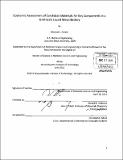| dc.contributor.advisor | Donald R. Sadoway. | en_US |
| dc.contributor.author | Parent, Michael C. (Michael Calvin) | en_US |
| dc.contributor.other | Massachusetts Institute of Technology. Dept. of Materials Science and Engineering. | en_US |
| dc.date.accessioned | 2012-03-16T16:04:01Z | |
| dc.date.available | 2012-03-16T16:04:01Z | |
| dc.date.copyright | 2011 | en_US |
| dc.date.issued | 2011 | en_US |
| dc.identifier.uri | http://hdl.handle.net/1721.1/69797 | |
| dc.description | Thesis (S.M.)--Massachusetts Institute of Technology, Dept. of Materials Science and Engineering, 2011. | en_US |
| dc.description | Cataloged from PDF version of thesis. | en_US |
| dc.description | Includes bibliographical references (p. 90-92). | en_US |
| dc.description.abstract | In order to satisfy the growing demand for renewable resources as a supply of electricity, much effort is being placed toward the development of battery energy storage systems that can effectively interface these new sources with today's electric grid. To be competitive with the prices dictated by the sources currently in use, namely fossil fuels, these new systems must be able to deliver energy at a cost of about $100/kWh for the active materials. Several battery systems have been developed and that target has been slowly coming into focus. The liquid metal battery attempts to redefine the typical storage system by maintaining components in a molten state and seeks to do so using cheap, widely available materials. One of the biggest problems facing the future of the LMB is that of resource scarcity. There are several candidate materials that can satisfy the operating needs of an LMB, but not all are available in large enough quantities to meet the new LMB demand without significant impact to the supply/demand equilibrium and, ultimately, price. A detailed model was built to investigate the use of various metals in this new technology and measure the impact expected as a result of large-scale LMB adoption. The report explains why antimony is the most likely candidate for the positive electrode due to its large, mature market and the relatively high energy output compared to other candidates. Alkali and alkaline earth materials make excellent candidates for the negative electrode and the vast quantities available will be more than enough to support the LMB market many times over. The analysis has also revealed a substantial concern that is often overlooked in battery development: electrolyte costs. The current use of ultra-pure, anhydrous salts cannot be sustained if the LMB is to be profitable and competitive. Large savings can be anticipated from purchasing tonnage-quantity salts, but the only way to bring these costs down to reasonable levels is through the use of lower-purity materials. This study shows that a reasonable LMB can be built with an active materials cost of less than $62/kWh and total system cost of around $1,000/kWh for a 1 MW facility. In the most optimistic case, assuming electrolyte costs on par with those of current battery technologies, the total sytem cost can be reduced to under $300/kWh, much cheaper than many of the most recent technologies. | en_US |
| dc.description.statementofresponsibility | by Michael C. Parent. | en_US |
| dc.format.extent | 98 p. | en_US |
| dc.language.iso | eng | en_US |
| dc.publisher | Massachusetts Institute of Technology | en_US |
| dc.rights | M.I.T. theses are protected by
copyright. They may be viewed from this source for any purpose, but
reproduction or distribution in any format is prohibited without written
permission. See provided URL for inquiries about permission. | en_US |
| dc.rights.uri | http://dspace.mit.edu/handle/1721.1/7582 | en_US |
| dc.subject | Materials Science and Engineering. | en_US |
| dc.title | Economic assessment of candidate materials for key components in a grid-scale liquid metal battery | en_US |
| dc.type | Thesis | en_US |
| dc.description.degree | S.M. | en_US |
| dc.contributor.department | Massachusetts Institute of Technology. Department of Materials Science and Engineering | |
| dc.identifier.oclc | 777954576 | en_US |

